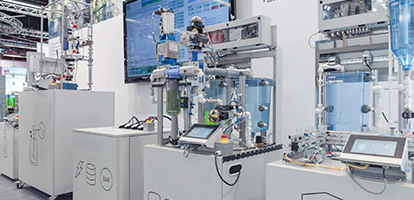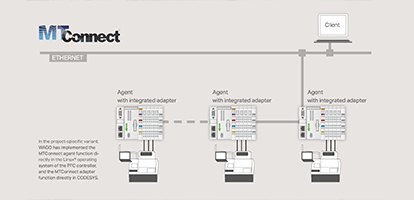


In Germany, OPC UA is the predominant means of integrating machines, whereas in North America, the preference is for MTConnect within the context of Industry 4.0. The protocol enables unidirectional communication between devices and superordinate command levels, for example, within a manufacturing execution system. Data transmission thereby follows an adapter-agent principle: the adapter reads analog or digital data from the machine or system via corresponding I/O modules and transmits it in a proprietary way to the agent, which conveys it to the control center via MTConnect.
In the project-specific technical implementation that WAGO uses, the CODESYS development environment – either WAGO-I/O-PRO running CODESYS 2 or e!COCKPIT running CODESYS 3 – and the real-time-capable Linux® operating system of the PFC controllers, play a decisive role. The MTConnect source code is freely available for Linux®, so the agent function can be implemented directly within the operating system. The communication between agent and adapter is, however, realized as a function block in CODESYS in a so-called “pipe delimited text” format. Configuration is carried out conveniently via the web-based management of the WAGO controllers.
Using the security options is easier with the updated firmware version 06: in addition, an individual configuration interface is provided on all PFC devices using Firmware 06 to configure OpenVPN, IPsec, and the firewall. The MTConnect queries to the agent can also be transmitted in encrypted format via HTTPS.
Designing versatile production systems
To satisfy the demands for individuality and to address the associated small quantities, the very structure of production must be changed; this is in addition to requirements for transferring data into and outside of production. The greatest challenges are volatile production quantities, which are increasingly difficult to predict. Moreover, a product alternative is always available for the consumer due to globalization, so product life cycles must become shorter. For these reasons, it is immensely important for businesses to bring new products to the market as quickly as possible. However, it is becoming increasingly more difficult to satisfy these demands in a cost-efficient manner using current production facilities.
This is why production facilities based on modular machines and systems capable of future change are required. Admittedly, concepts that reflect these modular notions and meet the technical requirements are required to implement these programs. The new DIMA automation architecture approximately describes this type of methodology for modular production systems. The concept, introduced by WAGO in late 2014, is useful for quickly adapting production modules to higher-level manufacturing computers. DIMA thus enables the uncomplicated and accelerated conversion of production facilities without requiring reprogramming of the primary processing computer. In this way, DIMA solves a core challenge of Industry 4.0.
Investments with success
Whether it’s a car, laptop, or one-off perfume, no one today waits for the delivery of their order as long as people waited for a Trabant in the sixties and seventies. This forces industry to invest significantly towards this goal. According to a study* by Strategy& and PwC, German businesses will invest 40 billion euros annually through 2020 in new structures for converting their production facilities using aspects of Industry 4.0. In the coming five years, around 80% of the horizontal and vertical value-added chain will be digitalized, and thus offer communicative transparency. The result is already visible today: production and resource efficiencies have already noticeably increased due to aspects of Industry 4.0.
Text: ULRICH HEMPEN and STEFAN KEGGENHOFF, WAGO
Photo: FOTOLIA, WAGO